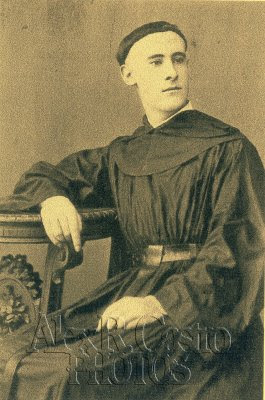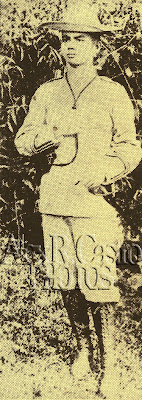LIFESTYLES OF THE RICH & FAMOUS. The Lopez Mansion, built by the sugar magnate Alejandro Lopez in the early 1930s, Guagua, Pampanga. The house is decorated for a religious celebration.
One of Pampanga’s most spectacular and most photographed landmarks is the Lopez Mansion, an imposing concrete residence and office built by the sugar magnate, Don Alejandro Lopez (b. 16 May 1883) of Guagua.
Alejandro was a product of the Philippine Normal School in 1911, and was for a time, connected with the Bureau of Education until 1920. But with the burgeoning sugar industry, Lopez became a successful planter, establishing the Lopez Rice Mill, Co., and becoming the Vice President of Pampanga Sugar Mills Planters Association.
For his wife Jacinta Limzon, Lopez built a spacious multi-storey mansion fit for a queen in the early 1930s. Constructed of APO Cement, the mansion also doubled as his office. Done in the Greek Revival style, the façade is dominated by Grecian columns accented with reliefs of foliate swags flowing down from the column's capital. Sandwiched in between are glass-panelled openings that lead to individual room balconies.
Concrete balusters line the building perimeter as well as the the 2nd floor protruding balconies where one can stand to watch the world go by. These were topped with eaves with simple geometric patterns, a design that recurrs around the house. Mini-pediments, evenly spaced out, crown the imposing structure, with cast-cement Grecian urns
The landing features a short flight of steps that leads to the main arched double doors. Two narrower doors flank the main portal, protected from the elements with a gracefully curving concrete canopy.
A spiral staircase linked the ground level to the upper rooms. The mansion was furnished with the latest styles from Puyat Furniture, the leading furniture and woodworking company of the day. Gonzalo Puyat, also from Guagua, established the factory that manufactured cabinets, bedroom suites, sala sets, tocadores, vegillas, sillas and even billiard tables of tangile and narra that became staples in wealthy Philippine homes.
The grounds were beautifully landscaped with flowering trees, small plants and shrubs. The perimeter is defined by a simple concrete and wrought iron fence. In its time, this mansion was an object of awe and attention, meriting write-ups in the Pampanga Social Register and Pampanga Directory, two who’s who books about Kapampangan high society.
It is fortunate that the Lopez Mansion still stands today, well-preserved after over 75 years. Indeed, the magnificence of this mansion would rival even some opulent residences in Europe, a singular showcase to the lifestyle of wealth and splendor as lived by Pampanga’s self-made men.
(*NOTE: Feature titles with asterisks represent other writings of the author that appeared in other publications and are not included in the original book, "Views from the Pampang & Other Scenes")












